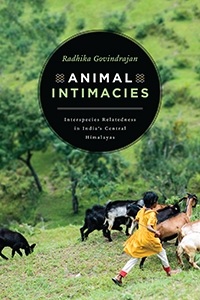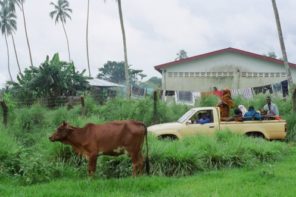In her book Animal Intimacies Radhika Govindrajan takes us through a series of human-animal relations in India’s Central Himalayas, the Kumaon division in the hills of Uttarakhand. Each chapter provides vivid stories that altogether form an insightful account of how affects play out in human-animal interactions. Perhaps the chapters could use more explicit linkages, but the book still presents a convincing representation of human-animals’ relations among India’s lower castes and highlands marginalised regions. The book focuses on the role of sacrificial goats (chapter 2); holy cows (chapter 3); troublesome monkeys (chapter 4); feral hogs (chapter 5); and sexy bears (chapter 6). These chapters discuss the links between love and ethics by conceiving intimacy between humans and animals as a form of reciprocal love and countering these intimacies with those who call for broader reforms for animal ethics such as the Hindu-nationalist animal rights groups in India as well as the global organisations decrying animal abuse in developing nations. Govindrajan specifically references such organisations as powerful entities that do not consider forms of intimacies that exist between people and animals. People like her interlocutors, she says, have “an ethical relatedness,” such as a woman who sacrifices her goat, a Hindu who consumes the meat of a Jersey cow, and the pahari villagers who want guns to cull the wild boar populations. These forms of relatedness derive from pahari peoples’ lives being entangled with and dependant on the lives and deaths of the multiple species of Kumaon. For example, a woman’s well-being is tied to the well-being of her cow: the author illustrates this relatedness by showing how the woman stays in a crumbling hut with the cow despite a dangerous storm. The central thesis is that this multi species relatedness comes through via human and nonhuman materialities. In other words, animal and human bodies are inter-connected via embodied practices, which she defines as aspects of life and death that leave behind visceral traces, such as bear scat, and directly physical, such as the ways in which a cow leans on the human who milks her. Human and animal bodies become transformed by affective encounters with each other.
In chapters 2 and
The central thesis is that this multi species relatedness comes through via human and nonhuman materialities. In other words, animal and human bodies are inter-connected via embodied practices, which she defines as aspects of life and death that leave behind visceral traces, such as bear scat, and directly physical, such as the ways in which a cow leans on the human who milks her. Human and animal bodies become transformed by affective encounters with each other.
These stories are not only about animals and their relatedness with humans but also about human politics. This becomes evident in Chapter 3, when Govindrajan describes the conflict between Hindu nationalists and pahari and lower castes people with regard to practices surrounding the holy cow. Against a backdrop of religiously justified violence against Muslim minorities, pahari people describe how some cows are less holy than others, in spite of the love and care that their owners’ manifest. As she explained in the introduction, Govindrajan spends time attending ethnographically to the movement and touches between cow and human bodies as well as the stories people tell her about cows to understand human-cow relatedness. The author highlights distinctions made between the Jersey cows and the pahari cows, both of which are local breeds of the region. A Jersey cow, a breed imported by British colonists and now taken up by the nationalist ruling party to increase milk production on an industrialized scale, is not considered as holy because, her Pahari interlocutors explain, her Jersey body is different. Indeed, a Jersey cow’s body has a more consistent milk supply, a fact that makes her belong to a different category. For Govindrajan’s interlocutors, these cows cannot be used in spiritual ceremonies. Through their bodies, Jersey cows also provide an exception to the taboo against bovine consumption. While this claim is convincing, one can also see how caste prejudice underpins this new categorization of “holy” versus “non-holy” cows. Since Jersey cow milk is produced in industrial quantities, it is often given to lower caste people to drink. According to taboos, a cow should stop producing milk when a lower caste person drinks it. When Jersey cows do not stop producing after being given to lower caste people, people do not feel as though their prejudice is undermined, instead, they create a distinctive category—the cow becomes less holy.
Is this an example of relatedness that transforms people’s perceptions or is this an example of an exceptional category being created to reinforce customary prejudices? The question is not explicitly addressed in the book but Govindrajan makes clear that caste prejudice alters bodily experiences as well. At one point the anthropologist describes a scene in a taxi whereby a man uncontrollably gags and vomits as the taxi enters a lower caste neighbourhood. This example demonstrates how embodied practices are revealing of caste prejudices, illustrating Govindrajan’s larger argument that both animal and human bodies influence politics.
Govindrajan spends time attending ethnographically to the movement and touches between cow and human bodies as well as the stories people tell her about cows to understand human-cow relatedness. The author highlights distinctions made between the Jersey cows and the pahari cows, both of which are local breeds of the region.
Chapter 4 introduces another central dichotomy: insider and outsider monkeys. It illuminates the tensions between urban and rural people in the forced influx of urban monkeys to rural spaces. As monkeys invade the cities, they are collected and then dumped into the forests of the Himalayas. Such practices leave them traumatized while orphaned baby monkeys tend to become more malicious as they struggle for survival. Urban monkeys, like urban people, disrupt the lives of the pahari people. They consume crops like an invasive species and they look and act differently from the forest monkeys who are used to live among the paharipeople. Govindrajan’s interlocutors are able to recognize these monkeys from their different hair and their lack of fear for humans— pahari monkeys, one person tells the anthropologist, are shy like pahari people. City monkeys’ nasty behavior mirrors the violence inflicted by city dwellers on mountain dwellers, who are forced out of their lands: outsider monkeys make the land unlivable. The chapter ends with a compelling moment of love that challenges such strict categorizations: the scene depicts an old man swearing in anger at city monkeys and a moment later, taking pity on an orphaned female juvenile and feeding her one of the pears her troop mates stole.
The next chapter presents a sow. The sow can transform back and forth between domesticated animals (like cows and goats) and the so-called ‘wild’ species (like monkeys and bears). Govindrajan provides a genealogy of both categories, domestic and wild, as colonial and racist legacies that persist today. Her interlocutors compare the dangerous hogs who forage in their high-value crops and attack humans with adult piglets of an escaped sow from a British-established laboratory. Noting that her interlocutors understood domesticity as part of a pig’s nature, no matter how “wild”, Govindrajan develops the concept otherwild to offer a local understanding of wilderness that does not fit neatly into the dichotomy of “wild” and “civilised”. The concept of otherwild enables people to imagine categories that exist beyond the colonial and nationalist norms of “civilised” and “wild” even if, eventually, it reinforces them. Otherwild better captures how the sow is locally perceived. She exists outside the framework of domination, allowing for people to imagine “a latent possibility of another world,” (123) a theme Govindrajan continues to develop in the penultimate chapter about bears who seduce women.
Is this an example of relatedness that transforms people’s perceptions or is this an example of an exceptional category being created to reinforce customary prejudices? The question is not explicitly addressed in the book but Govindrajan makes clear that caste prejudice alters bodily experiences as well.
Chapter 6, starts with a joke and a warning. Govindrajan’s friend warns her about the bears who might find her sexually appealing because they are generally attracted by city girls. The rest of the chapter recounts a folk tale in which bears kidnap women and force them into a cave for sex. At first, the story tells, the kidnapped woman is unwilling, but eventually, she enjoys sex with the bear. Despite the traumatic histories of abduction and mass sexual assaults that occurred during India’s Partition in 1947, Govindrajan contextualizes these sexy bears as moments of queered pleasure for the women. The women tell these stories in order to reclaim their sexual pleasure in a context where patriarchal relations and actual dangers of bear mauling impose significant restraints on their bodies.
Govindrajan’s ethnographic analysis of interspecies relations also explores relations among animals themselves. The book provides interesting scientific information on bears’ sexual behaviors, monkey trauma, pig bodies, cow milk production, and goat eating habits, hence reflecting the book series’ concern with biological anthropology. The Epilogue, focuses on a more familiar animal: a dog, whose death is, in the local belief system, giving life to a leopard. This story of a dog’s death closes the ethnography on a reflection on the imbrications between love and death, interspecies connections and human-nonhuman interactions. To love in this death-life way, Govindrajan suggests, is the only hope we have against the global catastrophe of human-made climate change.
Featured image (cropped) by Stephen Leonardi on Unsplash.









